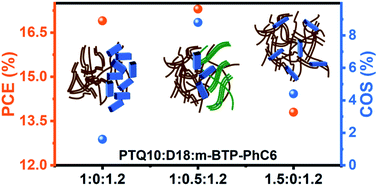Highly efficient organic solar cells with superior deformability enabled by diluting the small molecule acceptor content†
Abstract
Developing efficient organic solar cells (OSCs) with strong mechanical deformability is important to be addressed to ensure their operational reliability in wearable electronics. However, it is challenging to achieve mechanically robust polymer/small molecule OSCs with an efficiency over 17% due to the abundant brittle donor/acceptor (D/A) interface. Decreasing the small molecule content can reduce the brittle D/A interface area to enhance deformability, but it may also cause discontinuous electron-conducting regions and thus deteriorate photovoltaic performance. Here, we incorporate a polymer donor (D18) into a binary PTQ10cm-BTP-PhC6 system at a constant PTQ10:m-BTP-PhC6 ratio of 1 : 1.2 to minimize the D/A interfacial area and modulate phase separation, and subsequently fabricate mechanically reliable OSCs with high efficiency. The large incorporation of D18 molecules increases the crystallinity of m-BTP-PhC6 molecules because of the poor interaction between D18 and the two host materials, affording sufficient pathways for efficient charge percolation at a large D/A ratio. More importantly, highly aggregated m-BTP-PhC6 molecules help to minimize the D/A interfacial area, enabling ternary films with better deformability than their binary counterparts. As a result, ternary OSCs with a large D/A ratio of 1.5 : 1.2 exhibit a high efficiency of 17.3% with a crack-onset strain (COS) of 8.8%, which significantly outperforms their binary counterparts with an efficiency of 13.8% and a COS of 4.4%. Diluting the content of small molecules and controlling intermolecular interaction through the introduction of the second polymer donor represents a promising strategy to fabricate efficient OSCs with superior deformability.



 Please wait while we load your content...
Please wait while we load your content...